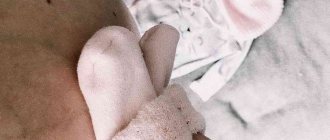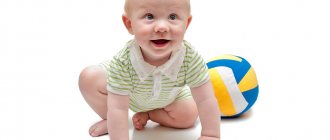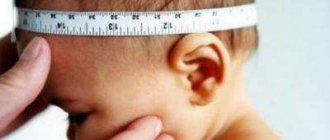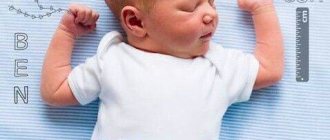In the first days, a newborn discovers a new universe, where everything is new to him, and much is hostile. The first days are extremely difficult for him, because he has to completely rebuild his life, feelings, and behavior.
During the nine months that passed inside the mother, the baby got used to a liquid environment, constant temperature, placental and umbilical nutrition. When a child is born, he takes his first breath, his first cry. It comes out of a liquid environment into a gaseous environment, where there is different lighting, different sounds, where many microbes fly.
Now he breathes on his own and will eat differently. His respiratory, digestive, and urinary organs will begin to work. And all this happens so quickly, at the same time, that the baby does not have time to adapt to new conditions.
How to care for the fontanel, and is it necessary to do it at all?
The fontanelles do not require any special care; it is only important to observe the parietal fontanel and try not to injure it while combing the hair and removing the crust. There are two fontanelles on the head of newborns: a small triangular one, which quickly closes, and a large parietal one in the shape of a diamond; this fontanel closes at about a year, sometimes up to a year and a half. If the fontanel does not close for a very long time, this indicates a lack of vitamin D in the child’s body. A fontanelle that is too convex can indicate increased intracranial pressure, while a fontanel that seems to have sunk inward can indicate a lack of fluid in the child’s body. In all these cases, it is necessary to contact a pediatrician; timely measures taken will prevent unwanted consequences in the future.
Is a pacifier necessary?
Every mother asks herself and those around her this question, and every mother has her own view on the pros and cons of a pacifier. Experts say that a breastfed baby rarely needs a pacifier, since the sucking reflex is completely satisfied, but from my personal example I can prove the opposite, I fed the child for more than a year, or rather a year and 1 month, while he and the pacifier were an inseparable friend for a month. 1.5 or even 2 longer, and then one day I had to part with her. While bottle-fed babies are in greater need of a pacifier, and this time my own experience does not contradict the opinion of experts, I grew up bottle-fed and the pacifier even went to kindergarten with me for some time. In any case, the advice is this: if the child does not ask for a pacifier, it is better not to insist, and there will be no harm and you will not have to wean him off.
First days at home
So, you were discharged from the maternity hospital, congratulations, flowers, photographs were left behind. You brought your baby home, but suddenly realized that you don’t know what to do next. If you are lucky and your baby was in the room with you, then you already have experience in swaddling and washing your baby. And if you were separate from him in the old fashioned way, then you will have to learn everything on your own.
Loving mothers begin their acquaintance with the baby by undressing and then carefully examining their bunny. The norm is if the baby's skin is soft, elastic, the mucous membranes are pink and moist, the cry is loud and strong.
In the maternity hospital, you have already fed the baby and, most likely, swaddled him. At home, you will take care of him yourself from day one. Wash after defecation, protect delicate skin from diaper rash. You will learn how to treat an umbilical wound in a week.
To understand a newborn's language, you will have to observe his behavior. Remember when approximately he sleeps, asks for food, wants to be with his mother. Soon, by his grunting or crying, you will understand what the baby wants at that moment.
At home, mothers who have their first children will have to learn everything in practice. Many people experience panic while washing and bathing a newborn; some are unable to properly establish feeding. However, almost all mothers cope with these tricks, and after a few weeks they behave quite confidently with their babies
The child breathes through his mouth. Is it harmful? So what should I do?
It is not recommended for a baby to breathe through the mouth, since frequent or constant breathing through the mouth leads to the formation of an incorrect bite, deviated nasal septums, throat diseases and colds (air passing through the nasal passage and nasopharynx heats up and enters the throat already warm, while the air enters through the mouth may be too cold for the baby) and a number of other troubles. To prevent this problem, it is necessary to regularly clean the baby’s nose with oil and cotton swabs, and also drip half a drop of saline into each nostril several times a day if the air in the room is too dry. If all measures have been taken, but the child is still breathing through the mouth, it is necessary to contact an otolaryngologist; perhaps there is a deviated septum, which goes away over time as the child grows up and the nose becomes larger accordingly. If during sleep the child still begins to breathe through his mouth, you do not need to give him a pacifier to close his mouth, try to lightly touch the baby’s mouth with your hand, he will reflexively close it and begin to breathe through his nose, if his nose is clean and nothing is obstructing his breathing .
Sensory development
A one-week-old baby can:
o involuntarily join hands and fingers, smile;
o perk up when you see mom or dad;
o Distinguish light from dark. In very bright light, blinks or closes eyes.
The baby's vision is blurry. He sees only the outlines of objects, and no further than 30 centimeters from his eyes. It distinguishes among them red or shiny ones, as well as those with an oval shape, and can track their movement with its eyes. The one-week-old baby does not remember people's faces; he recognizes his mother by smell and voice.
A one-week-old baby's hearing is better developed. A sleeping child, hearing a whisper above his crib, tosses and turns and blinks. The child can distinguish the speech of loved ones, but is more sensitive to the mother’s voice. True, he recognizes his father’s low voice better.
The sense of taste is present from birth. Sweet soothes, bitter and salty excite. The child immediately recognizes smells. The baby is sensitive to touch, which excites or calms him down.
How to treat a navel?
The most important rule is less moisture! More air! Try to prevent the wound on the navel from getting wet; to do this, fold the diaper and change diapers on time, take air baths, and if the air temperature in the room allows, keep the tummy open while the baby is awake. The wound must be treated with brilliant green or fucorcin, you can not be afraid and moisten it generously with the solution using a cotton swab, you can even drop a little inside the navel, just be careful, because if brilliant green or fucorcin leaks, not only the child, but everything around will get dirty.))) And of course, bathe your baby in a decoction of medicinal herbs, such as chamomile and string.
My chin is trembling, what should I do?
The cause of the so-called tremor (intense trembling) may be banal nervous overexcitation, for example, if the baby cried or actively splashed in the bath. This reaction is quite natural and gradually passes, it’s just that the nervous system of newborns is not perfect, not mature and is finally formed in the first year of the child’s life. If there were no visible reasons for overexcitation of the nervous system and the tremor occurs on its own, you need to tell a neurologist about it, whose visit is mandatory in the first month. The cause of such tremors may be increased muscle tone or, in other words, muscle hypertonicity. Which can be weakened with massage. Usually a massage is given to such babies with soft stroking movements, starting from the legs, but in this case it is necessary to start from the head, gradually moving lower and lower to the elbows, hands and palms, then the tummy, knees and feet. Exercises on the ball also help. It is necessary to place the baby on the massage ball with his tummy down in the “frog” position and gently rock and roll on this ball. Thanks to such movements, the muscles of the neck and abdomen become stronger, the umbilical ring closes better, and tension goes away. It is very good to take soothing baths with mint, lemon balm or valerian, not to be confused with an invigorating shower.))) But you should not overuse baths to avoid allergies, 2-3 times a week is enough. And of course, the child needs a calm and friendly atmosphere.
Baby care
Newborns' nails grow quickly, so it's worth purchasing scissors with rounded ends to cut them. This way the baby will not scratch himself or anyone around him. Naturally, all hygiene items must be individual.
A newborn needs regular cleaning of his nose and eyes. To remove mucus from the nose, you should purchase a special pear. Although you can get by with regular cotton swabs.
Natural fabrics that can be boiled are used for children's clothing. There should be no rough seams. Linen is washed with baby detergents and ironed on both sides. Soiled children's clothing is stored separately from adult clothing.
Children can be bathed immediately after discharge or the next day. Water temperature is 36-38 degrees. How many times? Bathing a baby with unscented baby soap is acceptable twice a week. Herbal decoctions are not used - they can cause allergies or dry out the baby's skin.
Baby dishes and pacifiers are boiled after use. But walks, massage and gymnastics are acceptable from 2-3 weeks of the baby’s life.
What are those white dots on the baby's face?
Very often, children develop small white dots on their faces that resemble acne. Actually, that’s what they are; the scientific name of these eels is milium. Milia appears in the last weeks before birth due to clogged pores. There is no reason to worry, the white dots will disappear after some time, there is no need to cauterize them, let alone pick them off; during the process of natural regeneration, the child’s skin will cleanse itself. You just need to wash your baby 2 times a day in the morning and evening, and also wipe the problem areas with breast milk like lotion.
Baby's behavior and activities with him
A special feature during this period is that the baby’s life is governed by conditioned reflexes: he wanted to eat, he cried, he got food. At the same time, the child does not yet understand that he can cry on purpose, for example, to attract his mother’s attention or to get what he wants. This reaction clearly expresses discomfort. It has absolutely nothing to do with character traits.
Of course, most newborns are inactive and lie for a long time in the position in which they were left in the crib. But there are also exceptions. They can move their arms and legs randomly, or, conversely, in a fairly orderly manner, for example, putting their limbs in their mouth.
The baby has a developed grasping reflex, so at the age of 1 week you can teach him to touch objects. To do this, either a rattle or the finger of one of the parents is alternately placed in his palm. The baby's fist instinctively clenches, and he feels the difference between the skin, warm and soft, and the plastic, cold and hard.
Experts offer:
o dance with a newborn;
o sing tender or lullaby songs to him;
o include classical or calm music compositions;
o call the baby by name;
o ring a quiet bell over the crib, moving it to the sides so that the baby follows it with his eyes;
o blow on the nose, arms and legs, stroke the child when bathing and changing clothes.
Before contacting the baby, be sure to wash your hands. Under no circumstances should it be shaken, and the head and neck need constant support.
The child’s temperature fluctuates; what body temperature is normal?
Newborns have an imperfect thermoregulation mechanism, so excessively wrapping the baby can lead to overheating and an increase in body temperature. Up to 37.5 C this can be considered normal, but if the temperature rises higher, the child is clearly overheated; if the high temperature does not decrease for a long time, it is necessary to call a doctor, since the high temperature may be a consequence of the disease, and small jumps in temperature up to the indicated mark can be considered the norm, especially if the room is hot or the child is dressed very warmly.
The child is crying, but no tears flow?
The reason for the lack of tears may be a membrane in the tear duct. Usually it bursts at birth, but there are cases when the membrane persists and then it needs to be removed. To do this, you need to contact an ophthalmologist. Since tears moisturize the mucous membrane of the eye, preventing it from drying out and protecting it from infections. Stagnation of tears in the tubule can cause inflammation of this very tubule and the mucous membrane of the eye. Before consulting a doctor, you can try the following procedure. Massage the baby's skin with light movements just below the tubercle on the inner corner of the eye. It is important not to press too hard and not to damage the delicate skin with your nails. This procedure must be carried out at least 10 times a day, that is, at any free time for 1-2 minutes, this allows the membrane to burst and open the tear duct. Otherwise, surgical intervention will be required, but there is no need to be afraid, the operation is performed under local anesthesia and is not complicated. The surgeon cuts the membrane with a thin wire, after which it is necessary to drop antibacterial drops into the baby’s eyes for several days to avoid inflammation. Very soon you won't even remember that the child had this problem.
Which bath to choose for bathing your baby?
All experts unanimously advise choosing a large bathtub over a baby bathtub.
In a larger space there is more room for movement; by actively moving, the baby not only trains his muscles, but also does not freeze if the water is a little cooler, thereby tempering his young body. Swimming helps not only train motor skills but also reduce muscle hypertonicity; in addition, after active swimming, the child’s sleep is stronger and more peaceful. For many children, especially those with congenital neuralgia, doctors recommend visiting swimming pools from birth, since swimming is an excellent therapy in cases of neuralgic abnormalities, and newborn children for some time after birth retain the instinct to hold their breath and, no matter how surprising it may sound, they can swim . Of course, bathing in a baby bathtub and even in a slide restricts the baby’s movements, but it is suitable for those mothers who are afraid of everything and makes the bathing process calmer. In any case, the choice is yours. Of course, every mother has many more questions than the nine described above, since each child grows and develops in his own way. The main thing in the first week of life is to establish such important life processes as feeding, sleeping and caring for the baby’s skin.
The cycle “Child up to one year” will be created for you, dear mothers, and together with you. If you have any questions or additions, be sure to leave your comment at the end of this article. I accept any wishes from you and will write about what interests you.
| Return to list |
Jaundice of newborns
The skin of a newborn in the first week may be yellow. This is physiological jaundice, which is considered normal. But there is also pathological jaundice. Jaundice appears due to an increased content of bilirubin, that is, a yellow-brown pigment formed during the breakdown of protein structures in the blood. A small amount of it is always present in the body, and this is not jaundice. It becomes clearly visible when 8-9 days have passed after the bruise has formed.
Bilirubin in newborns is higher than in adults, because their body does not remove it as actively. The baby in the womb cannot breathe on its own. It takes oxygen from red blood cells saturated with fetal hemoglobin. When a baby is born, this hemoglobin breaks down to form bilirubin. Therefore, its content in the blood of a recently born child is higher.
Bilirubin, which appears when fetal hemoglobin is destroyed, is called indirect. It is insoluble, so it is not removed from the body on its own. This will happen if indirect bilirubin turns into direct bilirubin, which is soluble. Only a mature enzyme system can do this. There is also a general ratio of bilirubin between direct and indirect. Direct bilirubin makes up three quarters of the total.
How much pigment is normal in the blood? Bilirubin in a newly born baby should not be higher than 60 µmol in one liter. By the third day, bilirubin rises to 205 µmol/liter, and by one month of age it decreases to 8.5 - 20.5 µmol/liter. Bilirubin in premature infants is 170 µmol in one liter of blood.
When is jaundice diagnosed? Blood for analysis in children is first taken from the umbilical cord. If the first and subsequent tests reveal an excess of bilirubin pigment, this is most likely jaundice. It happens:
o physiological jaundice, which is not dangerous for the baby;
o pathological jaundice, which is dangerous.
If left untreated, by six months the baby may have hearing loss and developmental delays behind the norm.










